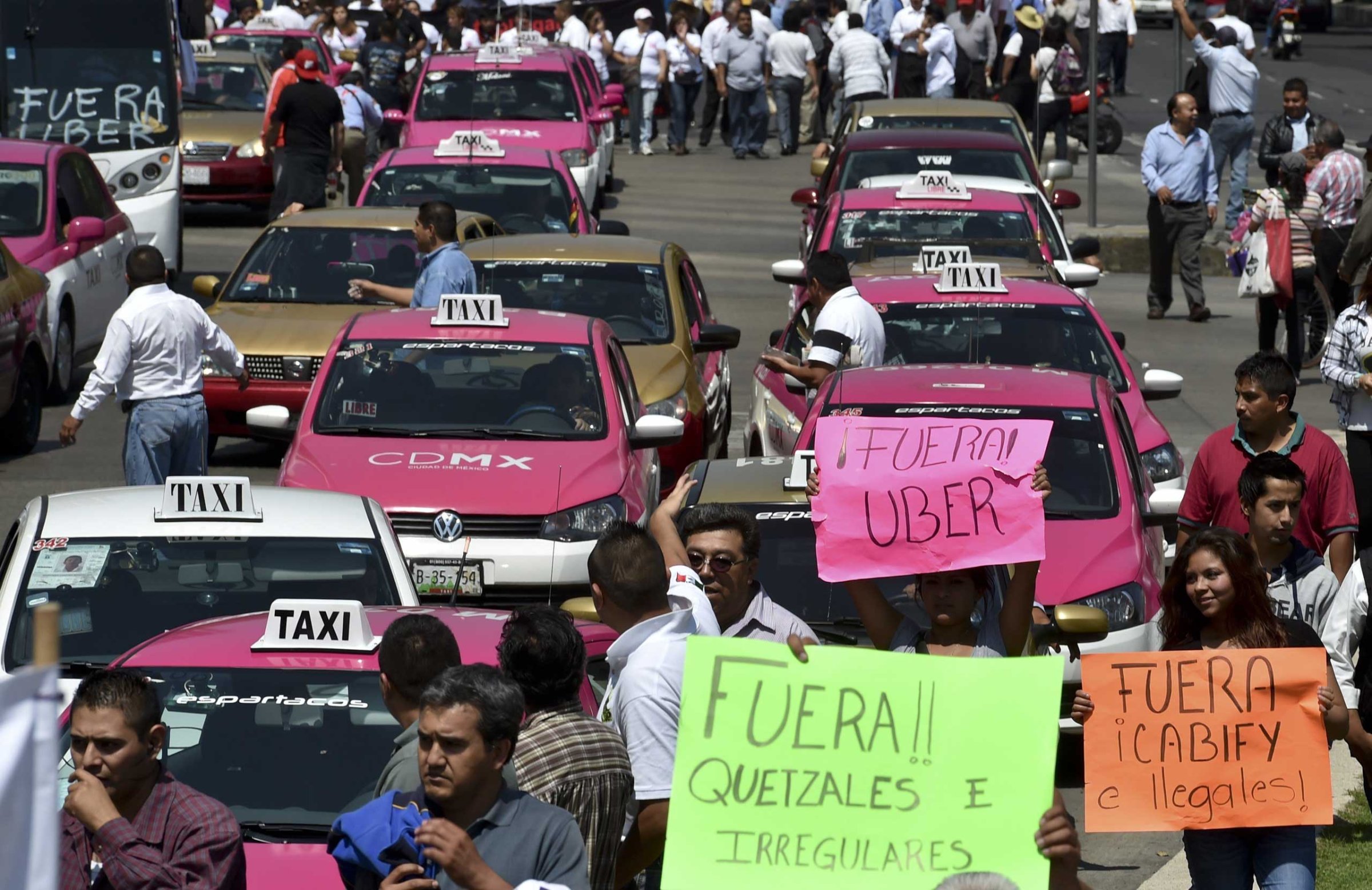
Driving through this megacity from a rundown slum to an upscale business hub, David Garcia takes precautions to not be recognized as an Uber taxi operator. He keeps his smart phone on his lap rather than fixed under the mirror where it can be seen from the street. If police stop him, he says he is a private chauffer. He avoids going to certain hotspots where he says that traditional taxi drivers have attacked his colleagues. He is concerned about the car getting damaged. But he is also worried about staying in one piece himself.
“The taxi drivers can be really aggressive. They can block you in and break your mirrors and scratch the car. They attacked a colleague by a taxi stand. They smashed all his windows and beat him,” says Garcia, a 27 year old who has been driving an Uber for four months. Yet despite the hassle, Garcia says he likes the work. “You have good chats with the passengers. And I like driving. The taxi drivers don’t scare me.”
This anger towards online cab services such as Uber and Cabify has hit the headlines here in recent weeks as leaders of traditional taxi drivers have decried what they say is unfair competition. Taxi associations have held a series of demonstrations calling for the government to clamp down on the new services, which people call from their smartphones. One leader even promised to “hunt down” the digitally registered cars. “We are not going to leave (Uber cars) alone. We are tracking these colleagues and hunting them down,” Esteban Meza, who represents about 13,000 cabbies, told the El Universal newspaper. “Without doubt this is going to generate big trouble.”
The meteoric rise of Uber, from a service in San Francisco to a billion-dollar global business, has sparked disputes from Delhi to Rome to Manila. It is perhaps unsurprising that they have got a little rough in Mexico, where conflicts between rival taxi services have a history of spilling into violence. In 2013, a cameraman took this video of a bloody battle between drivers of cabs and motor-taxis in the southern state of Oaxaca in which a man was killed.
Uber has also come into a big but crowded market for taxis in Mexico City. The sprawl with 20 million residents already has tens of thousands of traditional licensed cabs, alongside thousands more motorbike taxis, bicycle taxis, and so-called “pirates” or cabs without the correct papers. Licensed cabs complain they have to pay expensive rates for their permits, which Uber drivers shirk. Mexico City transport authorities also require traditional taxi drivers to take courses, touching issues such as anger management. And they make the cabbies paint their cars in a uniform recognizable color, adding yet more outlays. They are currently making thousands of taxis paint their cars pink. With the costs and competition, drivers often hit the smoggy gridlocked streets for 14 hours a day to make ends meet.
At one taxi stand in the upscale Polanco neighborhood, drivers complained that Uber cars are aggressive as they steal their customers. “They drive right into our stand’s space to pick up their passengers,” said Ramon Trujillo, as he operated the radio and ate a plate of tacos. “You ask them politely to move and they swear at you.” Worse still, he said, Uber had hit them in their wallets, making business fall by about 40% this year. “This is a foreign service that is taking our money,” Trujillo added. A percentage of the Uber fees go the California-based corporation.
Uber has especially hit Mexico City’s upscale neighborhoods as it carves out its niche among young professionals. More than 300,000 people in the city have downloaded the app, with which the registered cars can be seen on the app as thick as bees in some trendy areas. The service appeals by allowing customers to pay with plastic, get online receipts and trace their chauffeurs. This reduces fear of a random taxi driver on the street mugging them – a problem that plagued Mexico City in the past, and still happens occasionally.
Mexico City authorities have zig zagged on how they will deal with the Uber challenge. Transport officials met with taxi leaders and promised to look at regulation of the online taxi services. However, Mexico City mayor Miguel Angel Mancera said there would be no arrests of Uber or Cabify drivers in the meantime. In Mexico State, which incorporates much of the city’s slums and suburbs, the governor Eruviel Avila said that Uber is “not formally authorized.” Yet, it is still easy to digitally hail down a taxi there.
Frustrated with the lack of action, taxi leaders announced last week that they would create a National Front of Taxis to oppose the online services, which are spreading to other Mexican cities. They promised to challenge the digital competition both in the courts and on the street. However, their angry words in the media do little to dissuade drivers such as Garcia. He says he earns 2,300 pesos – or $150 – a week driving an Uber, more than he did in a previous job working on a stall and has no intention of turning back. “It is fine the taxi drivers speak out,” he says. “They are just giving us publicity.”
More Must-Reads from TIME
- Breaking Down the 2024 Election Calendar
- How Nayib Bukele’s ‘Iron Fist’ Has Transformed El Salvador
- What if Ultra-Processed Foods Aren’t as Bad as You Think?
- How Ukraine Beat Russia in the Battle of the Black Sea
- Long COVID Looks Different in Kids
- How Project 2025 Would Jeopardize Americans’ Health
- What a $129 Frying Pan Says About America’s Eating Habits
- The 32 Most Anticipated Books of Fall 2024
Contact us at letters@time.com